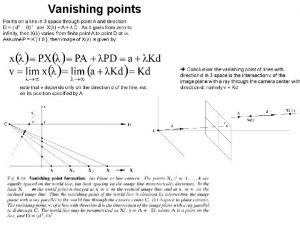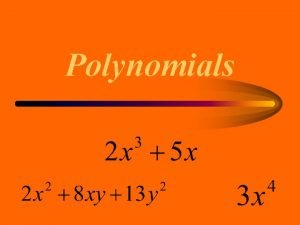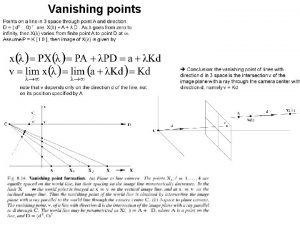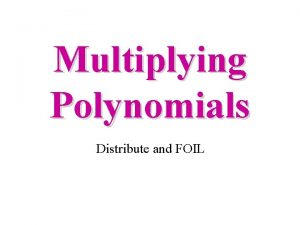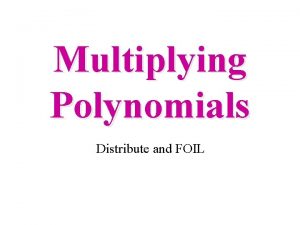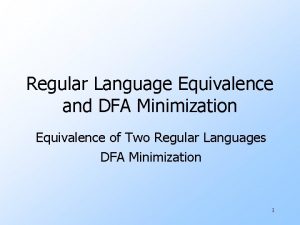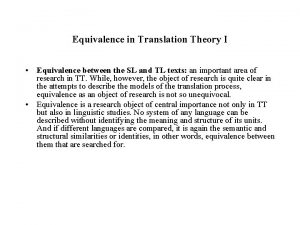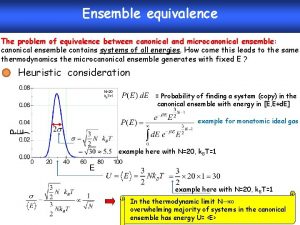Exploiting Vanishing Polynomials for Equivalence Verification of FixedSize





![Anti-Aliasing Function ØF 1[15: 0] = 156 x 6 + 62724 x 5 + Anti-Aliasing Function ØF 1[15: 0] = 156 x 6 + 62724 x 5 +](https://slidetodoc.com/presentation_image_h2/a449ea0a69c567a8d35fedc568b67468/image-6.jpg)




![Partition • Theorem 1: Let R be an equivalence relation on A. P={[a]| a Partition • Theorem 1: Let R be an equivalence relation on A. P={[a]| a](https://slidetodoc.com/presentation_image_h2/a449ea0a69c567a8d35fedc568b67468/image-11.jpg)





![Introduction to Rings • Let (R, +, ‧) be a ring, define by R[X]={anxn+an-1 Introduction to Rings • Let (R, +, ‧) be a ring, define by R[X]={anxn+an-1](https://slidetodoc.com/presentation_image_h2/a449ea0a69c567a8d35fedc568b67468/image-17.jpg)

![Vanishing Polynomials • Vanishing Polynomial f(x) Z 2 m[X], x Z 2 m f(x)=0 Vanishing Polynomials • Vanishing Polynomial f(x) Z 2 m[X], x Z 2 m f(x)=0](https://slidetodoc.com/presentation_image_h2/a449ea0a69c567a8d35fedc568b67468/image-19.jpg)
![Basic Number Theory • Let f(x), g(x) Z 23 [X], if (f-g): vanishing (1)23|(f Basic Number Theory • Let f(x), g(x) Z 23 [X], if (f-g): vanishing (1)23|(f](https://slidetodoc.com/presentation_image_h2/a449ea0a69c567a8d35fedc568b67468/image-20.jpg)

![Basis for factorization • Theorem 2: Sn(x) is vanishing in Z 2 m[X], where Basis for factorization • Theorem 2: Sn(x) is vanishing in Z 2 m[X], where](https://slidetodoc.com/presentation_image_h2/a449ea0a69c567a8d35fedc568b67468/image-22.jpg)























- Slides: 45

Exploiting Vanishing Polynomials for Equivalence Verification of Fixed-Size Arithmetic Datapaths GIEE , NTU ALCom Lab Presenter: 陳炳元

Outline • Introduction • Modeling • Univariate Vanishing Polynomials • Algorithm of Univariate • Multi-varite Vanishing Polynomials • Algorithm of Multi-varite • Conclusions and Future Work

Outline • Introduction • Modeling • Univariate Vanishing Polynomials • Algorithm of Univariate • Multi-varite Vanishing Polynomials • Algorithm of Multi-varite • Conclusions and Future Work

Bit-Vector Arithmetic = %2 m Algebra ØRepresent integers as a vector of bits ØBit x 0 represents values 0 or 1 ØVector X[1: 0] = {x 1, x 0} represents integers Ø 00, 01, 10, 11 ØBit-vector of size m: integer values in 0, …, 2 m-1 ØVector X[m-1 : 0] represents integers reduced % 2 m

Fixed-Size (m) Data-path: Modeling • Control the datapath size: Fixed size bit-vectors (m) • Bit-vector of size m: integer values in 0, …, 2 m-1 Fixed-size (m) bit-vector arithmetic Polynomials reduced %2 m Algebra over the ring Z 2 m
![AntiAliasing Function ØF 115 0 156 x 6 62724 x 5 Anti-Aliasing Function ØF 1[15: 0] = 156 x 6 + 62724 x 5 +](https://slidetodoc.com/presentation_image_h2/a449ea0a69c567a8d35fedc568b67468/image-6.jpg)
Anti-Aliasing Function ØF 1[15: 0] = 156 x 6 + 62724 x 5 + 17968 x 4 + 18661 x 3 + 43593 x 2 + 40244 x +13281 ØF 2[15: 0] = 156 x 6 + 5380 x 5 + 1584 x 4 + 10469 x 3 + 27209 x 2 + 7456 x + 13281 Now that polynomially F 1 F 2 because they have different coefficients; But because the datapath size is fixed to 16 bits F 1[15: 0]= F 2[15: 0], or in other words F 1 % 216 = F 2 % 216

Outline • Introduction • Modeling • Univariate Vanishing Polynomials • Algorithm of Univariate • Multi-varite Vanishing Polynomials • Algorithm of Multi-varite • Conclusions and Future Work

Binary Relation • Let A be a set, R is a subset of A A, we say that R is a binary relation on A • Let R be a binary relation. We sometimes write a. Rb for (a, b) R • A binary relation R on A is called reflexive if(x, x) R for all x A • A binary relation R on A is called symmetric if(x, y) R (y, x) R for all x, y A • A binary relation R on A is called transitive if(x, y) R and (y, z) R (x, z) R for all x, y, z A

Equivalence Relation • A binary relation R on A is called equivalence relation if it is reflexive, symmetric, transitive • • A equivalence relation R on A. We define the equivalence class of a, [a]={b A| (a, b) R } • Example: Let A=Z , if (a, b) R a b mod n. Then [0], [1], …, [n-1] are all equivalence class

Partition • Let A be a set. A partition of A is a collection of disjoint nonempty subsets of A. The equivalence classes of R on A form a partition of A. Lemma 1: Let R be an equivalence relation on A. The following statements are equivalence: (1) (a, b) R (2) [a]=[b] (3) [a] [b] {}
![Partition Theorem 1 Let R be an equivalence relation on A Pa a Partition • Theorem 1: Let R be an equivalence relation on A. P={[a]| a](https://slidetodoc.com/presentation_image_h2/a449ea0a69c567a8d35fedc568b67468/image-11.jpg)
Partition • Theorem 1: Let R be an equivalence relation on A. P={[a]| a A} P is partition of A pf: 顯然 Claim: [a] [b], then [a] [b]={} If [a] [b] {} By the lemma 1, we have [a]=[b] 故P為A之一partition

Partition • Example: • Let A=Z , if (a, b) R a b mod n. Then corresponding to equivalence class set Zn={[0], [1], …, [n-1]} Note: We sometimes write Zn={0, 1, …, n-1}

Binary Operation • Let S be a set. : S S S function, then we say that is a binary operation on S • if is a binary operation on S then we will write a b rather than (a, b). • (S, 1, 2, …, K) is a set S together with k binary operation 1, 2, …, K on S

Introduction to Rings • A ring (R, +, ‧) is a set, R together with two binary operation +, ‧on R called addition and multiplication, satisfying the following properties: (1)(R, +) is an abelin group. We write the identity element 0 (2)Multiplication is associative, means that a (b c)=(a b) c a, b, c R (3)The left and right distributive laws hold, means that a (b+c)=a b+a c and (a+b) c=a c+b c a, b, c R

Introduction to Rings • Example: 我們在Z上定義一個equivalence relation, 若(a, b) R a b mod n 對應之equivalence class set Zn={[0], [1], …, [n-1]}. 在Zn上定義兩個binary operation +, by [a]+[b]=[a+b mod n]與[a] [b]=[ab mod n] (Zn+, ‧): ring NOTE: (1) [a], [b] Zn, [a]+[b]=[a+b mod n]=[b+a mod n]=[b]+[a] and [a] [b]=[ab mod n]=[ba mod n]=[b] [a] (2) [a] Zn, [a]+[0]=]=[a+0 mod n]=[a] and [a] [1]=[a 1 mod n]=[a]

Introduction to Rings • A ring R is called a commutative ring if ab=ba a, b R • A ring R is called a ring with unity 1 if there is an element 1 0 in R such that 1 a=a=a 1 a R Example: (1) Z, Q, R, C: commutative ring with unity 1 where the ring operations are the usual addition and multiplication. (2)Let n be a positive integer. Then the set Zn={0, 1, …, n-1}, under addition and multiplication modulo n is commutative ring with unity 1.
![Introduction to Rings Let R be a ring define by RXanxnan1 Introduction to Rings • Let (R, +, ‧) be a ring, define by R[X]={anxn+an-1](https://slidetodoc.com/presentation_image_h2/a449ea0a69c567a8d35fedc568b67468/image-17.jpg)
Introduction to Rings • Let (R, +, ‧) be a ring, define by R[X]={anxn+an-1 xn-1+· · ·+a 1 x+a 0| n , ai R, i=1, 2, . . . , n} is called the ring of polynomials over R In fact, R[X] is ring Example: (Z 3, +, ‧), f(x)=2 x 3+1, g(x)=x+2 f(x)+g(x)= 2 x 3+x and f(x) g(x)=2 x 4+x 3+x+2=2 x 4+2 x+2

Outline • Introduction • Modeling • Univariate Vanishing Polynomials • Algorithm of Univariate • Multi-varite Vanishing Polynomials • Algorithm of Multi-varite • Conclusions and Future Work
![Vanishing Polynomials Vanishing Polynomial fx Z 2 mX x Z 2 m fx0 Vanishing Polynomials • Vanishing Polynomial f(x) Z 2 m[X], x Z 2 m f(x)=0](https://slidetodoc.com/presentation_image_h2/a449ea0a69c567a8d35fedc568b67468/image-19.jpg)
Vanishing Polynomials • Vanishing Polynomial f(x) Z 2 m[X], x Z 2 m f(x)=0 • f(x), g(x) Z 2 m[X] if(f-g): vanishing means that 2 m | (f-g) • n! divides a product of n consecutive numbers 4! divides 99 X 100 X 101 X 102 • Find least n 2 m|n! Smarandache Function (SF) SF(23) = 4, since 23|4! 2 m divides the product of n = SF(2 m) consecutive numbers
![Basic Number Theory Let fx gx Z 23 X if fg vanishing 123f Basic Number Theory • Let f(x), g(x) Z 23 [X], if (f-g): vanishing (1)23|(f](https://slidetodoc.com/presentation_image_h2/a449ea0a69c567a8d35fedc568b67468/image-20.jpg)
Basic Number Theory • Let f(x), g(x) Z 23 [X], if (f-g): vanishing (1)23|(f - g) in Z 23 (2) 23|4! (3) 4! divides the product of 4 consecutive numbers (4) x Z 23, 4!|(x+1)(x+2)(x+3)(x+4) • Write (f-g) as a product of SF(2 m) = n consecutive numbers

Basis for factorization ØY 0(x) = 1 ØY 1(x) = (x + 1) ØY 2(x) = (x + 1)(x + 2) : Product of 2 consecutive numbers ØY 3(x) = (x + 1)(x + 2)(x + 3) : Product of 3 consecutive numbers Ø… Ø… ØYn(x) = Yn-1(x) (x + n) : Product of n consecutive numbers
![Basis for factorization Theorem 2 Snx is vanishing in Z 2 mX where Basis for factorization • Theorem 2: Sn(x) is vanishing in Z 2 m[X], where](https://slidetodoc.com/presentation_image_h2/a449ea0a69c567a8d35fedc568b67468/image-22.jpg)
Basis for factorization • Theorem 2: Sn(x) is vanishing in Z 2 m[X], where n = SF(2 m). • Example: • f = x 4 +2 x 3 + 3 x 2 + 2 x Z 23 [X]; SF(23) = 4 • f can be written as a product of 4 consecutive numbers. f= (x+1)(x+2)(x+3)(x+4) = Y 4(x) • f is a vanishing polynomial.

Constraints on the Coefficient • Example: • h(x) = 4 x 2 + 4 x = 4(x+1)(x+2) = 4 S 2(x) Z 23[X]; SF(23) = 4 • h(x) =0 x Z 23 • h is a vanishing polynomial. • But h(x) not equal to S 4(x) • Theorem 3: 2 m/gcd(k!, 2 m) Yk(x)=0 in Z 2 m[X], 0 k SF(2 m), 2 m/gcd(k!, 2 m) 為使 2 m/gcd(k!, 2 m) Yk(x)=0之min NOTE: b Yk(x)=0 in Z 2 m[X] 2 m/gcd(k!, 2 m) |b

Constraints on the Coefficient • Example: • h(x) = 4 x 2 + 4 x = 4(x+1)(x+2) = 4 Y 2(x) Z 23[X] • 23/gcd(2!, 23) | 4 • h is a vanishing polynomial.

Deciding Vanishing Polynomials • Theorem 4: • Let F be a polynomial in Z 2 m[X]. Then F is vanishes F = Fn. Yn + k=0 Σn-1 ak bk Yk Theorem 2 Theorem 3 Øn = SF(2 m), i. e. the least n such that 2 m|n! ØFn is an arbitrary polynomial in Z 2 m[x] Øak is an arbitrary integer Øbk = 2 m/gcd(k!, 2 m)

Outline • Introduction • Modeling • Univariate Vanishing Polynomials • Algorithm of Univariate • Multi-varite Vanishing Polynomials • Algorithm of Multi-varite • Conclusions and Future Work

Algorithm Procedure zero_Identifi(polynomial, 2 m) 1. Calculate n = SF(2 m) 2. k = n: Reduce according to Throrem 2 Divide by Sn If remainder is zero, then F = Fn. Yn, else Continue

Algorithm 3. Reduce according to Theorem 3. Divide by Yn-1 to Y 0 Check if quotient is a multiple of bk = 2 m/gcd(k!, 2 m) If remainder is zero, then stop. else continue

Example 1 p= 4 x 2 + 4 x in Z 23 1. n = SF(23) = 4 2. k = 4: Divide by Y 4 deg(p) = 2< deg(Y 4)= 4 quo = 0, rem = 4 x 2 + 4 x F 4 = 0; Continue 3. k = 3: Divide by S 3 deg(p) = 2<deg(S 3) = 3 quo= 0, rem = 4 x 2 + 4 x continue 4. k = 2: Divide by Y 2 quo = 4; rem = 0 b 2 = 23/gcd(2!, 23) = 4 a 2 = quo/ b 2 =1 Z p is a vanishing polynomial in Z 23

Example 2 p= 5 x 2 + 3 x + 7 in Z 23 1. n = SF(23) = 4 3. k = 3: Divide by Y 3 deg(p) = 2<deg(Y 3) = 3 quo= 0, rem = 5 x 2+3 x + 7 continue 2. k = 4: Divide by Y 4 deg(p) = 2< deg(Y 4) = 4 quo = 0, rem=5 x 2+3 x + 7 4. k = 2: Divide by Y 2 quo = 5; rem = 4 x+5 F 4 = 0; Continue b 2 = 23/gcd(2!, 23) = 4 a 2 = quo/ b 2 =5/4 Z p is not a vanishing polynomial in Z 23

Outline • Introduction • Modeling • Univariate Vanishing Polynomials • Algorithm of Univariate • Multi-varite Vanishing Polynomials • Algorithm of Multi-varite • Conclusions and Future Work

Multiple Polynomial • Definition: • (1) Let R be a ring, define the ring R[x 1, …, xn ] of polynomial in the indeterminates x 1, …, xn recursively as follows: R[x 1, …, xn ] = (R[x 1, …, xn-1])[xn] • (2) x 1 i 1…xnin is called monomial , ax 1 i 1…xnin is called monomial term, where a為此term之coefficient • (3) The degree of x 1 i 1…xnin is (i 1, …, in) n denote deg(x 1 i 1…xnin)

Multiple Polynomial If R is a commutative and f(x 1, …, xn) R[x 1, …, xn ], then the mapping : R R given by (a 1, …, an) The mapping is called polyfunction. In this problem, : Z 2 n 1 … Z 2 nd Z 2 m • Definition: Let k=(k 1, k 2, …, kd) n, we define Yk=yk 1(x 1)…ykd(xd), where yki(xi) is the falling factor of degree ki in xi

Example • F(x 1, x 2)=x 14 x 2 + 2 x 13 x 2+ 3 x 12 x 2+ 2 x 1 x 2 over Z 22[x 1, …, xn ] 1. sf(22)=4 2. F=Y(4, 1) (x 1, x 2)=Y 4(x 1)Y 1(x 2)=0 in Z 22 • We wish to generalize these results to analyze polyfunctions over Z 2 n 1 … Z 2 nd Z 2 m

Lemma 8 (1) Z 2 then Y 2 ni (xi)=0, i=1, 2, …, d (2)Let n=sf(2 m) then Yn(x)=0 Take i=min{2 ni, sf(2 m)} , i=1, 2, …, d then Y i Z 2 is vanshing polynomial ni ni • Lemma: Let k=(k 1, k 2, …, kd) n, then Yk=0 ki i, for some i

Example • F(x 1, x 2)=x 12 x 2 - x 1 x 2 be a polynomial corresponding to the polyfunction : Z 21 Z 22 Z 23. We show that F is a vanshing polynomial. 1. sf(23)=4, 1=2, 2=4 2. x 12 x 2 - x 1 x 2 =x 1(x 1 -1) x 2=Y(2, 1) (x 1, x 2) 3. k 1 1=2 The condition in lemma is satisfied, Hence F is vanshing polynomial

Constraints on the Coefficient • Theorem 8: • The expression ck Yk=0 in Z 2 m[X] d 2 m/gcd( i=1 ki!, 2 m) | ck ¨ck Z 2 m ¨k=(k 1, k 2, …, kd) n such that ki i, i=1, 2, …, d

Example • F(x 1, x 2)=4 x 1 x 22 + 4 x 1 x 2 be a polynomial corresponding to the polyfunction : Z 21 Z 22 Z 23. We show that F is a vanshing polynomial. 1. 2 n 1=2, 2 n 2=4, sf(23)=4, 1=2, 2=4, 2. 4 x 1 x 22 + x 1 x 2 =4 x 1 x 2 (x 1 -1) = c(1, 2) Y(1, 2) (x 1, x 2) 3. 8/gcd( 1!x 2!, 8) | c(1, 2)且k 1 1=2, k 2 2=4 The condition in lemma is satisfied, Hence F is vanshing polynomial

Deciding Vanishing Polynomials • Theorem: Let F be a polynomial representation for the functiond from Z 2 n 1 … Z 2 nd to Z 2 m. Then F is vanishes F = i=1 Qi. Y (i) + Σakbk. Yk Lemma 8 Theorem 8 Øn = SF(2 m), i. e. the least n such that 2 m|n! Øk=(k 1, k 2, …, kd) n, for each ki=1, 2, …, i ØY (i) is falling factor of degree i ØQi is an arbitrary polynomial Øak is an arbitrary integer Øbk = 2 m/gcd(k!, 2 m)

Outline • Introduction • Modeling • Univariate Vanishing Polynomials • Algorithm of Univariate • Multi-varite Vanishing Polynomials • Algorithm of Multi-varite • Conclusions and Future Work


Example

Outline • Introduction • Modeling • Univariate Vanishing Polynomials • Algorithm of Univariate • Multi-varite Vanishing Polynomials • Algorithm of Multi-varite • Conclusions and Future Work

Conclusions and Future Work

Thank You
 Diastereotopic vs enantiotopic
Diastereotopic vs enantiotopic Dynamic and formal equivalence
Dynamic and formal equivalence Koller 5 types of equivalence
Koller 5 types of equivalence Large and fast: exploiting memory hierarchy
Large and fast: exploiting memory hierarchy Virtual value chain
Virtual value chain Algorithm for recovery and isolation exploiting semantics
Algorithm for recovery and isolation exploiting semantics Define new entry in entrepreneurship
Define new entry in entrepreneurship Exploiting machine learning to subvert your spam filter
Exploiting machine learning to subvert your spam filter Exploiting format string vulnerabilities
Exploiting format string vulnerabilities What is a sport/event entity?
What is a sport/event entity? What is a structure in technology
What is a structure in technology Raphael perspective
Raphael perspective Vanishing gradient
Vanishing gradient Ideal properties of cleansing cream
Ideal properties of cleansing cream I am the vanishing gland
I am the vanishing gland Glycerogelatins
Glycerogelatins City drawing with vanishing point
City drawing with vanishing point Vanishing
Vanishing The vanishing pumpkin
The vanishing pumpkin Gradient vanishing problem
Gradient vanishing problem Example of inorganic emulsifying agents
Example of inorganic emulsifying agents Substitution table
Substitution table What is a vanishing point apex
What is a vanishing point apex Father of renaissance painting
Father of renaissance painting Auxiliary vanishing point
Auxiliary vanishing point Vanishing gradient problem
Vanishing gradient problem Vem räknas som jude
Vem räknas som jude Tack för att ni lyssnade
Tack för att ni lyssnade Kyssande vind analys
Kyssande vind analys Boverket ka
Boverket ka Verksamhetsanalys exempel
Verksamhetsanalys exempel Typiska drag för en novell
Typiska drag för en novell Varför kallas perioden 1918-1939 för mellankrigstiden?
Varför kallas perioden 1918-1939 för mellankrigstiden? Stål för stötfångarsystem
Stål för stötfångarsystem Vanlig celldelning
Vanlig celldelning Tack för att ni har lyssnat
Tack för att ni har lyssnat Rådet för byggkompetens
Rådet för byggkompetens Cks
Cks Var 1721 för stormaktssverige
Var 1721 för stormaktssverige Påbyggnader för flakfordon
Påbyggnader för flakfordon A gastrica
A gastrica Egg för emanuel
Egg för emanuel Relativ standardavvikelse formel
Relativ standardavvikelse formel Karttecken ruin
Karttecken ruin Rutin för avvikelsehantering
Rutin för avvikelsehantering Trög för kemist
Trög för kemist






















